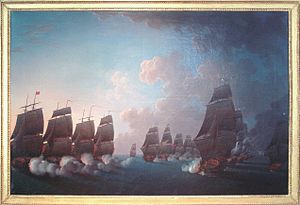Battle of Martinique (1780)
| Battle of Martinique | |||||||
|---|---|---|---|---|---|---|---|
| Part of The American Revolutionary War | |||||||
 Combat de la Dominique, 17 Avril 1780, by Auguste Louis de Rossel de Cercy (1736–1804) |
|||||||
|
|||||||
| Belligerents | |||||||
|
|
|
||||||
| Commanders and leaders | |||||||
| Sir George Rodney | Comte de Guichen | ||||||
| Strength | |||||||
| 20 ships of the line | 23 ships of the line | ||||||
| Casualties and losses | |||||||
| 120 killed 354 wounded |
222 killed 537 wounded |
||||||
The Battle of Martinique, also known as the Combat de la Dominique, took place on 17 April 1780 during the American Revolutionary War in the West Indies between the British Royal Navy and the French Navy.
In January 1780, the Comte de Guichen was sent to the French base at Martinique in the West Indies with a large squadron. He was opposed by the British admiral Sir George Rodney, who reached the British base at St. Lucia in late March.
Guichen sailed from Martinique on 13 April 1780, with a fleet of 23 ships of the line and 3,000 troops. His objective was to draw Rodney out, and then withdraw and make an attack on either St. Lucia or the British base at Barbados. Rodney sailed out at once upon being informed that Guichen had sailed. On 16 April, his sentinels spotted Guichen on the leeward side of Martinique, beating against the wind. Rodney gave chase, but was unable to close in time for battle that day. Rodney maintained contact with Guichen and held his line throughout the night.
The fleets began manoeuvring for the advantage of the weather gage on the morning of 17 April. By 8:45, Rodney had reached a position to the windward of Guichen, in a relatively close formation. To escape the danger to his rear, Guichen ordered his line to wear and sail to the north, stringing out the line in the process. This forced Rodney to go through another series of manoeuvres to regain his position, which he did by late morning. At this point, he hoped to engage the rear and centre of Guichen's elongated line, concentrating his power to maximize damage there before Guichen's van could join the action. The signal that Rodney issued was for each ship to engage the appropriate ship it was paired with according to the disposition of the two fleets. He issued this signal with the understanding that his captains would execute it in the context of signals given earlier in the day that the enemy's rear was the target of the attack.
...
Wikipedia
